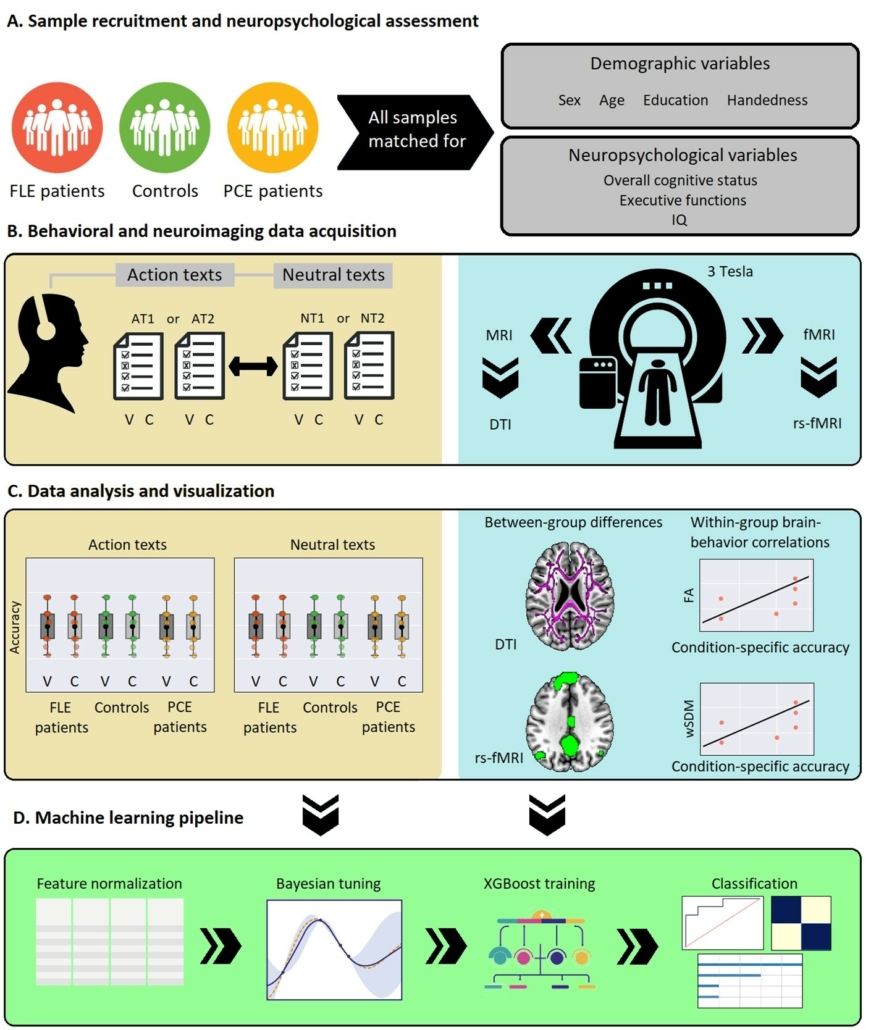Multimodal neurocognitive markers of frontal lobe epilepsy: Insights from ecological text processing
NeuroImage
Moguilner, S., Birba, A., Fino, D., Isoardi, R., Huetagoyena, C., Otoya, R., Tirapu, V., Cremaschi, F., Sedeño, L., Ibáñez, A., & García, A. M. (2021). Multimodal neurocognitive markers of frontal lobe epilepsy: Insights from ecological text processing. NeuroImage 235, 117998.
En este estudio empleamos nuestra tarea validada de procesamiento de narrativas de acción para detectar marcadores específicos de pacientes con epilepsia del lóbulo frontal (ELF), en comparación con personas sanas y pacientes con epilepsias posteriores (EP). Los pacientes con ELF mostraron déficits selectivos y específicos en la aprehensión de acciones, asociados a alteraciones estructurales y funcionales en redes cerebrales motoras. Estas anomalías, en conjunto, permitieron identificar a pacientes con ELF de los participantes de los otros dos grupos con un 75% de precisión. Tales resultados sugieren que una tarea lingüística naturalista, complementada con medidas cerebrales multinivel, puede contribuir de modo no trivial a la búsqueda de marcadores específicos de ELF.
Para acceder al artículo hacé click aquí.
Multimodal neurocognitive markers of frontal lobe epilepsy: Insights from ecological text processing
NeuroImage
Moguilner, S., Birba, A., Fino, D., Isoardi, R., Huetagoyena, C., Otoya, R., Tirapu, V., Cremaschi, F., Sedeño, L., Ibáñez, A., & García, A. M. (2021). Multimodal neurocognitive markers of frontal lobe epilepsy: Insights from ecological text processing. NeuroImage 235, 117998.
The pressing call to detect sensitive cognitive markers of frontal lobe epilepsy (FLE) remains poorly addressed. Standard frameworks prove nosologically unspecific (as they reveal deficits that also emerge across other epilepsy subtypes), possess low ecological validity, and are rarely supported by multimodal neuroimaging assessments. To bridge these gaps, we examined naturalistic action and non-action text comprehension, combined with structural and functional connectivity measures, in 19 FLE patients, 19 healthy controls, and 20 posterior cortex epilepsy (PCE) patients. Our analyses integrated inferential statistics and data-driven machine-learning classifiers. FLE patients were selectively and specifically impaired in action comprehension, irrespective of their neuropsychological profile. These deficits selectively and specifically correlated with (a) reduced integrity of the anterior thalamic radiation, a subcortical structure underlying motoric and action-language processing as well as epileptic seizure spread in this subtype; and (b) hypoconnectivity between the primary motor cortex and the left-parietal/supramarginal regions, two putative substrates of action-language comprehension. Moreover, machine-learning classifiers based on the above neurocognitive measures yielded 75% accuracy rates in discriminating individual FLE patients from both controls and PCE patients. Briefly, action-text assessments, combined with structural and functional connectivity measures, seem to capture ecological cognitive deficits that are specific to FLE, opening new avenues for discriminatory characterizations among epilepsy types.
To access the full paper, click here.



